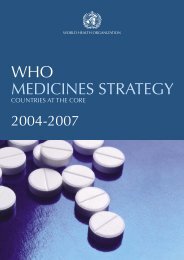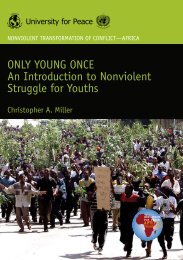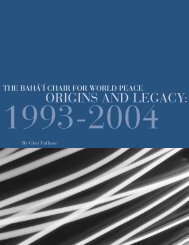environmental degradation as a cause of conflict in - Steiner Graphics
environmental degradation as a cause of conflict in - Steiner Graphics
environmental degradation as a cause of conflict in - Steiner Graphics
You also want an ePaper? Increase the reach of your titles
YUMPU automatically turns print PDFs into web optimized ePapers that Google loves.
and reaches 1000mm <strong>in</strong> Jabal Marrah highlands.Accord<strong>in</strong>gly, the vegetation cover <strong>in</strong>cre<strong>as</strong>es <strong>in</strong> a southward direction. The variation<strong>in</strong> the climate – ra<strong>in</strong>fall, soil and temperature, resulted <strong>in</strong> six ecological zoneswith vary<strong>in</strong>g farm<strong>in</strong>g and livestock systems and livelihoods. Ecologically Darfur suffersfrom <strong>environmental</strong> variability, recurrent droughts, gra<strong>in</strong> shortages, desertification,and biodiversity loss and water poverty <strong>in</strong> parts <strong>of</strong> the Region.Soils and water resourcesSoilsSoils <strong>in</strong> Darfur are predom<strong>in</strong>antly (sixty percent) sandy (qoz) generally suitable forcrops like Dukhun, groundnuts, watermelon and sorghum. There are some scatteredgardud soils (clay) and gravel rock soils. It is estimated that less than fifty percent<strong>of</strong> the cultivable land is used. There are, for example, about twenty-four million feddanssuitable for cultivation <strong>in</strong> South Darfur <strong>of</strong> which only 7.2 million are utilizedfor ra<strong>in</strong>fed farm<strong>in</strong>g, <strong>in</strong> addition to seventy-six thousand feddans <strong>in</strong> horticulture.Sandy soils suitable for agriculture <strong>in</strong> North Darfur amount to about seven millionfeddans, but less than half is farmed. Clay soils <strong>in</strong> North Darfur amount to abouttwo million feddans with only ten to fifteen percent utilized. Land tenure presentsa major constra<strong>in</strong>t for agriculture <strong>in</strong> Darfur.WaterIn addition to ra<strong>in</strong>fall, the water resources <strong>in</strong> Darfur <strong>in</strong>clude the wadis and groundwater.There are <strong>in</strong> Darfur 12 identified wadis, 3 <strong>in</strong> North Darfur and 9 <strong>in</strong> SouthDarfur, with a total amount <strong>of</strong> discharge <strong>of</strong> 993.8 million cubic meters. Water fromthe wadis is collected by dam and hafirs and used for human and livestock consumption.There is some limited water harvest<strong>in</strong>g. The long-term strategy (2000-27) targets some three hundred thousand feddans to be irrigated from wadi waterestimated at 0.9 milliard cubic meters.The groundwater <strong>in</strong> Darfur is found <strong>in</strong> the Nubian sandstone aquifer and othersestimated at 2,400 billion m3. There is a large potential <strong>of</strong> groundwater to irrigateone million five hundred thousand feddans <strong>in</strong> Sag Al Naaim, Wadi Hawar etc…Water development <strong>in</strong> Darfur is constra<strong>in</strong>ed by <strong>in</strong>adequate evaluation <strong>of</strong> the watersources (Hydrology and geology), <strong>in</strong>adequate f<strong>in</strong>anc<strong>in</strong>g and the sandy nature <strong>of</strong>the soil with high rate <strong>of</strong> evaporation which limits water harvest<strong>in</strong>g, <strong>in</strong> addition tothe geo-morphological changes <strong>cause</strong>d by the recurr<strong>in</strong>g droughts.In spite <strong>of</strong> these constra<strong>in</strong>ts, the water program for Darfur 2000 – 2003 revealsnotable progress (Table 1).87











